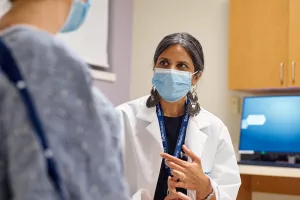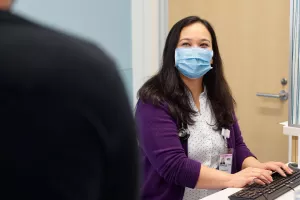Eosinophilic esophagitis (EoE) occurs when white blood cells called eosinophils create inflammation in the esophagus. If you have EoE, our team of experts will use innovative treatment techniques to get you feeling like yourself again.
Getting your food from A to B
Your esophagus is the bridge between your mouth and stomach. Any time you swallow food or liquid, the muscles that make up your esophagus push it down for digestion. Since we swallow hundreds of times a day on average, you're bound to feel even the slightest irritation in your esophagus.
EoE was first recognized as a disease in the 1990s, and we're learning more about it all the time. We apply that knowledge to your care plan so you can regain the full strength of your esophagus.

Conditions
Both children and adults can get EoE, but the symptoms are slightly different.
If you think that your child might have EoE, look for these symptoms:
- Abdominal pain
- Difficulty swallowing
- Food getting stuck in the esophagus
- Trouble eating (also known as feed dysfunction)
- Vomiting
In adults, EoE symptoms include:
- Chest pain that's resistant to antacids
- Difficulty swallowing solid foods and food impaction
- Heartburn
- Persistent cough
- Upper abdominal pain
Are food allergies and EoE connected?
Yes, food allergies can trigger EoE. It's important to know that the type of food allergy associated with EoE is quite different from food allergies you might be familiar with.
EoE-triggered food allergies only affect the esophagus. This differs from "common" food allergies, where reactions include hives, swelling and wheezing.
Testing
If your symptoms align with EoE, our team of experts will use the latest diagnostic tools to determine what’s causing your discomfort.
Among the 2 most common tests for EoE are:
- Esophageal biopsy: The doctor uses a thin tube to take a small tissue sample of your esophagus for examination.
- Upper endoscopy: A thin tube with a camera on the end looks for signs of EoE.
If the team suspects that ya food allergy causes your EoE, tests like skin prick testing, patch testing and blood tests can help identify your food trigger(s).
Once we learn if you have EoE and understand what may be causing it, we’ll create a unique treatment plan tailored to your needs.
Treatments
EoE can be treated in many different ways. If a food allergy triggers the condition, we’ll recommend dietary therapy. Cutting out certain foods like dairy and wheat products can help reduce inflammation.
We may also prescribe medication or a treatment called dilation. Dilation stretches your esophagus out gradually, making it easier to swallow.

From regular office visits to inpatient stays, find the healthcare you need and deserve close to home.

Meet the doctors and care team devoted to supporting you every step of the way along your path to better health.